

A bus dropped us at the train station and we waited for the Train Bleu. This small blue train, basically the only train in Corsica, was to take us from Ajaccio to Vizzavona. Ajaccio is an urban area with large boats, roads and buildings of no particular interest, so we decided that the best way to kill time while awaiting the train was to nurse a drink at the station's bar.
The train was crowded and it was hard to find a spot for us and our huge backpacks. Only after the train started did we realize that we had no way to know in advance when to get off it... Happily, we were able to recognize Vizzavona by the long uphill tunnel which ends immediately before its station. Vizzavona is one of the only places with two parallel railroad tracks, so you'll often find another train here waiting to cross yours.
After switching shoes and filling our flasks with water, we left towards Monte d'Oro. We didn't want to spend the night in the village, so we had decided we'd walk for one or two hours and find some place to sleep in the forest. The maps showed a few springs up there, which we hoped to find. From Vizzavona's station, we followed the GR20 towards Col de Vizzavona on a few hundred yards and crossed the torrent on a small bridge. There we found the start of the path to Monte d'Oro, marked out with splotches of yellow paint.
After a walk of about an hour, we agreed that the real world had nothing to do with the map as far as forest trails were concerned - probably because new trails are often opened by foresters. So, we gave up on finding the spring showed on the map. We did find a tiny stream of water though, and since the path seemed to be the only flat space within miles, we decided to spend the night on it. This path sees little traffic and we wake up early; doing so is otherwise not recommended... We had a hard time falling asleep because of the many mosquitoes drawn by the water. This is usually not a problem after a good day's effort, but this was our first night and we weren't tired enough. Anyway, I rejoiced at the thought of spending the next two weeks in the middle of nowhere - and it was to be even better than I thought.
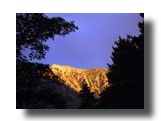 We got up slightly before the sun appeared and watched the sky change colors while we packed our things.
At one point it looked as if the other side of the valley was already enjoying full daylight, while it
was still dark at our camp. We were surprised to see a lone German hiker walk through the mess we had
scattered on the path - he must have left the village early.
We got up slightly before the sun appeared and watched the sky change colors while we packed our things.
At one point it looked as if the other side of the valley was already enjoying full daylight, while it
was still dark at our camp. We were surprised to see a lone German hiker walk through the mess we had
scattered on the path - he must have left the village early.We left as horizontal shafts of light started piercing the forest. We had a long day ahead of us, since the plan was to climb Monte d'Oro's East side and to go down its West ridge till refuge de l'Onda, so there was no time to waste. The wheather and the morale were excellent, but the packpacks loaded with food seemed incredibly heavy on this first day.
 As usual, I couldn't decide whether I should keep my camera inside the backpack or carry it in my hand. When
I put it inside, I usually find something great to photograph and I have to throw the bag on the floor and
get the camera out as quickly as possible; on the other hand, when I keep it outside, bad luck usually strikes
and I end up carrying it around and risking its safety to no avail. Over the years, I have finally developed
a habit of throwing the backpack down, tearing the camera out of it, rushing to the scene of interest, shooting,
and putting everything back into place as quickly as possible. It looks very hectic...
As usual, I couldn't decide whether I should keep my camera inside the backpack or carry it in my hand. When
I put it inside, I usually find something great to photograph and I have to throw the bag on the floor and
get the camera out as quickly as possible; on the other hand, when I keep it outside, bad luck usually strikes
and I end up carrying it around and risking its safety to no avail. Over the years, I have finally developed
a habit of throwing the backpack down, tearing the camera out of it, rushing to the scene of interest, shooting,
and putting everything back into place as quickly as possible. It looks very hectic...
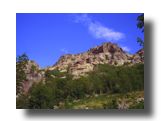 The path up to Monte d'Oro is very well marked out and easy to follow. I used this opportunity to try out my
altimeter, which kept giving me incorrect data. By now I have learned that these things should be adjusted often
and that their data should be taken with a grain of salt. To speak plainly, keep telling it where you are,
never ask it where you are... It does help when one is really lost, but if one relies too much on it, it mainly
helps get lost!
The path up to Monte d'Oro is very well marked out and easy to follow. I used this opportunity to try out my
altimeter, which kept giving me incorrect data. By now I have learned that these things should be adjusted often
and that their data should be taken with a grain of salt. To speak plainly, keep telling it where you are,
never ask it where you are... It does help when one is really lost, but if one relies too much on it, it mainly
helps get lost!
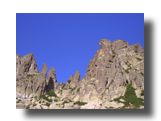 Our path led us near a characteristic rock known as la Cafetière (the coffee pot) because of its peculiar
shape. Then came a steep passage called la Scala - a fitting name indeed, since it looks more like a ladder than
a path!
Our path led us near a characteristic rock known as la Cafetière (the coffee pot) because of its peculiar
shape. Then came a steep passage called la Scala - a fitting name indeed, since it looks more like a ladder than
a path!
When we finally reached the summit and discovered the view towards the West, we noticed that the horizon was blocked by a huge, rapidly approaching thunderstom. It had remain undetected until now because we were coming from the East! Sitting on the highest point within miles during a storm didn't sound like a good idea, so we ran down about 50m and hid under large rocks.
 The storm travelled fast, so it didn't last long. We had just about enough time to finish our lunch and were
glad to leave our shelter: water was beginning to flow on our rock seats. We walked down Monte d'Oro's West
ridge and a timid sun shone above small Lac d'Oro.
The storm travelled fast, so it didn't last long. We had just about enough time to finish our lunch and were
glad to leave our shelter: water was beginning to flow on our rock seats. We walked down Monte d'Oro's West
ridge and a timid sun shone above small Lac d'Oro.
We reached the GR20 again at Punta Muratello and followed it down to refuge de l'Onda, under a pounding hailstorm. The wheather in Corsica is usually heavenly, but Corsica is a mountaineous area and it can be unpredictable.
We were rather exhausted when we reached the camping place and went to sleep early. Unfortunately it was crowded with people hiking the GR20, some of whom weren't very silent. We were to leave the GR for good the next morning, and would not regret it.
One good thing about this place, though, was that we were able to purchase a piece of cheese from the shepherds. It was excellent, albeit expensive. Dry and salty. This was the beginning of a "cheese connoisseur's quest" for the best Corsican cheese...
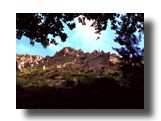 This path is part of Mare a Mare North, which crosses Corsica from East to West, and is marked out with orange
paint. As many Corsican paths, it seems to have been an important road in the past: portions are supported
by stone walls, and it passes through a deserted village at Guarchetta. It's now a nice, unfrequented route.
Most of the time it stays high in the forest, but at one point it lowers till the river, allowing hikers to
have a welcome bath.
This path is part of Mare a Mare North, which crosses Corsica from East to West, and is marked out with orange
paint. As many Corsican paths, it seems to have been an important road in the past: portions are supported
by stone walls, and it passes through a deserted village at Guarchetta. It's now a nice, unfrequented route.
Most of the time it stays high in the forest, but at one point it lowers till the river, allowing hikers to
have a welcome bath.
 We found no springs on the way and were low on water when we reached Chiusa, in the afternoon. There was no
fountain in sight, so we asked inhabitants whether there was one in the village. To our surprise, they
immediately offered us glasses of water, with ice cubes! What a luxury - we didn't expect that much. They
also showed us a spring hidden behind a house, which we wouldn't have found by ourselves.
We found no springs on the way and were low on water when we reached Chiusa, in the afternoon. There was no
fountain in sight, so we asked inhabitants whether there was one in the village. To our surprise, they
immediately offered us glasses of water, with ice cubes! What a luxury - we didn't expect that much. They
also showed us a spring hidden behind a house, which we wouldn't have found by ourselves.
After a short walk uphill, we reached l'Ugnica, where we intended to buy food and spend the night. The grocery shop was closed, as it was time for the afternoon siesta. We were prepared to take a nap while waiting for the evening, but some children spotted us and alerted the owner, who came down and opened her shop for us.
As usual, we had no idea where to sleep. Sleeping in villages isn't easy, since the only flat spots are usually private gardens. We asked her if she knew of any appropriate place, and she immediately offered a spot in her own garden. Once again, we were pleasantly surprised. Corsican hospitality is really something - the same scenario was to happen again several times.
We had coffee with her. She mentioned with pride that Napoleon III had donated a gold candelabrum to the village's church. When we asked where to see it, she answered it had long disappeared - some priest must have sold it...
 We left early (around 4:30am) and followed the road to Pastricciola. There, we left the road and found the path
again, which went up towards Col de Messicella. It was dawn when we left Pastricciola and we
were barely able to see the orange marks; that was the best way to guarantee a climb in the cool morning air.
We left early (around 4:30am) and followed the road to Pastricciola. There, we left the road and found the path
again, which went up towards Col de Messicella. It was dawn when we left Pastricciola and we
were barely able to see the orange marks; that was the best way to guarantee a climb in the cool morning air.The end of the climb was steep and my heart was pounding when we reached the pass. The forest up there teems with wild pigs and boars. The terrain looked as if it had been shelled; boars had dug huge holes looking for food. Boars were nowhere to be seen; pigs are easier to spot, as they don't fear men. Although they are called wild, I believe they do have an owner; but they live on their own in the forest.
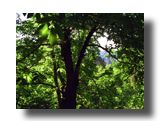 The path down to Guagno crosses a beautiful forest of chestnut trees. There we met the mayor of Guagno, who
again told us where to find water at the village, and also gave us some instructions to find the path from
Guagno to Orto, mentioning an old, rusty bridge which was not to be trusted.
The path down to Guagno crosses a beautiful forest of chestnut trees. There we met the mayor of Guagno, who
again told us where to find water at the village, and also gave us some instructions to find the path from
Guagno to Orto, mentioning an old, rusty bridge which was not to be trusted.
 At Guagno we bought some fresh food and left towards Orto. The two villages are separated by a small punta
and by the valley of Fiume Grosso. From the ridge of Punta a u Pirello, we discovered Orto and stopped for
lunch and a siesta.
At Guagno we bought some fresh food and left towards Orto. The two villages are separated by a small punta
and by the valley of Fiume Grosso. From the ridge of Punta a u Pirello, we discovered Orto and stopped for
lunch and a siesta.
 Orto seemed very near us and it was no higher, but to reach it we had to go down to the river, cross it, and
climb back up on the other side. The path down the hill was really interesting; it zig-zagged through a maze
of old stone walls, and we would have had a hard time finding our way without the paint marks.
Orto seemed very near us and it was no higher, but to reach it we had to go down to the river, cross it, and
climb back up on the other side. The path down the hill was really interesting; it zig-zagged through a maze
of old stone walls, and we would have had a hard time finding our way without the paint marks.
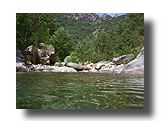 At the river, we avoided the bridge as instructed. We would have avoided it anyway, just by the looks of the
gaping holes in it! The river formed natural pools here and the water was unbelievably hot - we took a long bath.
It was particularly spectacular to swim under the impressive shape of Monte Sant' Eliseo.
At the river, we avoided the bridge as instructed. We would have avoided it anyway, just by the looks of the
gaping holes in it! The river formed natural pools here and the water was unbelievably hot - we took a long bath.
It was particularly spectacular to swim under the impressive shape of Monte Sant' Eliseo.
We started towards Orto without drying our clothes, but everything was dry by the time we got there, and the climb felt wonderfully fresh. The village is built on a very steep slope, with almost 100m vertically between the first and the last houses. Finding a place to sleep didn't look easy - we asked some people if they had any idea where to find a suitable spot, and one of them immediately voluntereed to take us to his "ranch" with his car. That was the place where his horse usually lived; fortunately the animal wasn't there, and the fence allowed us to sleep without fear of pigs.
We spent part of the evening in the lively pub, and went to sleep early, as always. Orto had proved to be a very nice place.
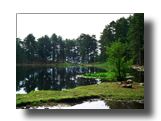 The path goes straight up through a chestnut forest to the crest above Orto. This is the very kind of climb
that should be done early in the morning (i.e. at dawn). If you're caught there at nine o'clock, you'll know
what "hot" means. The path reaches the crest at a broken concrete cross, joins the path which comes up from
Soccia and reaches Lac de Creno. This lake surroundered by forest is renowned for its unique looks, and we
were far from alone there despite the early time of day.
The path goes straight up through a chestnut forest to the crest above Orto. This is the very kind of climb
that should be done early in the morning (i.e. at dawn). If you're caught there at nine o'clock, you'll know
what "hot" means. The path reaches the crest at a broken concrete cross, joins the path which comes up from
Soccia and reaches Lac de Creno. This lake surroundered by forest is renowned for its unique looks, and we
were far from alone there despite the early time of day.
Unfortunately it started raining at that point - the wheather wasn't very typical that summer. Typical summer in Corsica's mountains is hot and dry everyday, except a few brutal storms now and then. While most people were going down, we went on up. A few hours later, the rain had stopped and we reached Bocca d'Acqua Ciarnente, a pass whose peculiarity is a small pond of water located at the very ridge. Behind it lies Plateau du Campotile, a large, flat area, surprisingly green and rich. We settled near the abandoned shepherd's hut at Lenze, which has a good spring. The wheather was clear again, but cold and very windy, and was to stay so for the next few days. We dropped by the shepherd's at Vaccaghia and bought some cheese for dinner. The night was excellent, thanks to a thick grass carpet.
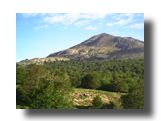 We woke up in a fresh and clear morning. We were to follow river Tavignano, whose source was nearby, down the
valley. Nothing difficult was planned that day, the path being mostly level. The huge pyramid of Punta Artica
loomed above us as we left.
We woke up in a fresh and clear morning. We were to follow river Tavignano, whose source was nearby, down the
valley. Nothing difficult was planned that day, the path being mostly level. The huge pyramid of Punta Artica
loomed above us as we left.
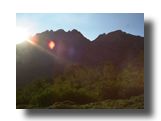 At noon, we reached Bocca a l'Arinella, a pass on the crest which separates the Golo valley from the Tavignano
valley. The place is not very interesting in itself but offers a beautiful view on Calacuccia, a large village
sitting near its artificial lake, and some of the most impressive summits in Corsica: Paglia Orba, Cinque Frati,
Monte Cintu, Capu Verdatu, Capu Biancu.
At noon, we reached Bocca a l'Arinella, a pass on the crest which separates the Golo valley from the Tavignano
valley. The place is not very interesting in itself but offers a beautiful view on Calacuccia, a large village
sitting near its artificial lake, and some of the most impressive summits in Corsica: Paglia Orba, Cinque Frati,
Monte Cintu, Capu Verdatu, Capu Biancu.
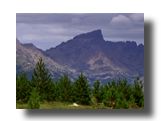 Paglia Orba is the mountain I like most in Corsica. Very impressive, it is only accessible from the South. All
other sides are 500m high rock walls. It is made of a beautiful red rock and the view from there is great - the
sea looks so near one could almost touch it. This time it was dark and looked rather intimidating.
Paglia Orba is the mountain I like most in Corsica. Very impressive, it is only accessible from the South. All
other sides are 500m high rock walls. It is made of a beautiful red rock and the view from there is great - the
sea looks so near one could almost touch it. This time it was dark and looked rather intimidating.
 We could have walked down directly to Calacuccia, but we had an interesting variant in mind: following the crest
towards the East to the Pinerole, a small, unimpressive summit, little known but with a great panorama. From
Bocca a l'Arinella, we first followed the road towards the East, so as to avoid climbing Capu di a Vorba. This
road goes to the shepherd's hut at Conia, which is where we were headed, but isn't interesting. We left it
after a short while and climbed through the forest, towards the shepherd's hut at Vorba. We found a path, marked
out with cairns, leading to it. Near the hut, where the shepherd was asleep, is an excellent spring.
We could have walked down directly to Calacuccia, but we had an interesting variant in mind: following the crest
towards the East to the Pinerole, a small, unimpressive summit, little known but with a great panorama. From
Bocca a l'Arinella, we first followed the road towards the East, so as to avoid climbing Capu di a Vorba. This
road goes to the shepherd's hut at Conia, which is where we were headed, but isn't interesting. We left it
after a short while and climbed through the forest, towards the shepherd's hut at Vorba. We found a path, marked
out with cairns, leading to it. Near the hut, where the shepherd was asleep, is an excellent spring.
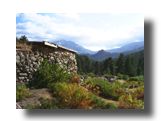 From there on, we followed the crest towards the East. There is no path but the terrain is easy, and the view on
Calacuccia is wonderful. At Bocca di Conia, we left the crest by turning right, following a small path, and
reached the hut at Conia. It had only been recently deserted; it still contained lots of equipment and some food,
including 20 loafs of bread that looked about one year old. We even had mattresses for the night.
From there on, we followed the crest towards the East. There is no path but the terrain is easy, and the view on
Calacuccia is wonderful. At Bocca di Conia, we left the crest by turning right, following a small path, and
reached the hut at Conia. It had only been recently deserted; it still contained lots of equipment and some food,
including 20 loafs of bread that looked about one year old. We even had mattresses for the night.
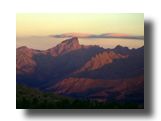 From Conia, we quickly reached Bocca a Canaghia, and followed the ridge till the summit of Pinerole. The sun
had barely appeared when we reached the top. There was a terrible wind and the wheather was very clear, except
a weird, flat cloud above Paglia Orba. In front of the Paglia, the Cinque Frati (the Five Monks) were clearly
visible.
From Conia, we quickly reached Bocca a Canaghia, and followed the ridge till the summit of Pinerole. The sun
had barely appeared when we reached the top. There was a terrible wind and the wheather was very clear, except
a weird, flat cloud above Paglia Orba. In front of the Paglia, the Cinque Frati (the Five Monks) were clearly
visible.
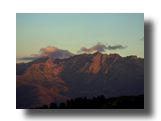 Monte Cinto, Corsica's highest point, was also clearly visible in front of us, as well as the road which comes
from Calacuccia up to Ercu and allows climbing the Cinto in a single day.
Monte Cinto, Corsica's highest point, was also clearly visible in front of us, as well as the road which comes
from Calacuccia up to Ercu and allows climbing the Cinto in a single day.
The rest of day proved very interesting. We were to climb down Pinerole towards Calacuccia. It was delicate. First, we had to reach the shepherd's hut at Ciaretta. This was rather easy, since the hut could be seen from the summit, but one had to carefully choose a path. The terrain was mostly rocky, with patches of alders, which are almost impenetrable and are to be avoided. The hut was obviously still in use, but the shepherd was nowhere in sight.
The second part of the descent was more tricky. After the hut we entered the forest and could no longer see where we were headed. There wasn't even a hint of a path; happily there were cairns here and there which helped find the way. We lost the way on several occasions and found the cairns again lower. After a while, we reached a point where the path crosses from the left bank to the right bank of ruisseau de Pruniccio. There we realized that we had forgotten the map at our last stop, about 100m higher! We had to run back uphill, hoping not to get lost while looking for the map. We were helped by the cairns, some of which we had built on our way down... we didn't think they would be useful to us! We did find the map and came back to the river. From then on we were always careful not to leave anything behind us... At this point we felt we knew this forest rather well! In fact the terrain was good and one could walk anywhere without difficulty - the only problem was to know where to go.
The third part of the descent was the most painful. The path left the forest and entered an area covered with low, thorny bushes. The path had obviously been abandoned a long time ago. It was difficult to find and there was no way to avoid the thorns. After several hours of walking through the bushes, our morale was rather low and our skin was sensitive to the touch of a feather! Happily there were some blackberry bushes in there, and we spent some time eating. Sitting in a sea of thorns under a heavy sun makes one really feel far from civilization.
We finally reached the large road in Scala di Santa Regina and followed it up to Calacuccia. Walking alongside the road is not nice. There are paths, but the one we tried was muddy, blocked with brambles, and to make things even better, there were a few cows in there which kept blocking our way. I don't know how we managed to get out of there. I wouldn't recommend any of these paths.
There are youth hostels in Calacuccia. The one we tried wasn't particularly commendable, but a hot shower was the best thing in the world after such a day - not to mention an ice cream at a sunny terrace. We met a very nice fellow from Nice who recommended a restaurant in Olmi Capella as "mythical". We decided to pay it a visit later, and had dinner in a nice restaurant in Sidossi.
Our goal was to reach Bocca di Serra Piana, one of the few passes between Niolo and Asco, but since this was supposed to be a short day, we planned to find a place to sleep somewhere above Corscia. The map showed several springs along the way so it looked possible.
 The hill behind Corscia was a maze! There were stone huts and walls everywhere, making it very difficult to
guess which way led to Serra Piana. We asked some elders who went to great lengths to explain everything
precisely. I must say, however, that a few minutes after leaving them, we had again absolutely no idea where
to go. We decided to go roughly in the right direction, ignoring all walls and paths. It worked; we found the
right path on the first ridge above Corscia.
The hill behind Corscia was a maze! There were stone huts and walls everywhere, making it very difficult to
guess which way led to Serra Piana. We asked some elders who went to great lengths to explain everything
precisely. I must say, however, that a few minutes after leaving them, we had again absolutely no idea where
to go. We decided to go roughly in the right direction, ignoring all walls and paths. It worked; we found the
right path on the first ridge above Corscia.
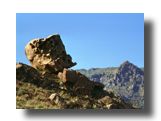 We found the first spring as expected at the top of ruisseau de Cruma. It was a nice place, but the spring had
been turned into a mud hole by cows, so we decided to go further. We still had plenty of time. It was a beautiful
place, with little vegetation but lots of weird rocks, and an incredible light.
We found the first spring as expected at the top of ruisseau de Cruma. It was a nice place, but the spring had
been turned into a mud hole by cows, so we decided to go further. We still had plenty of time. It was a beautiful
place, with little vegetation but lots of weird rocks, and an incredible light.
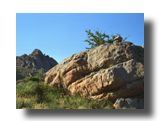 The path disappeared and we had some fun looking for it. Happily the terrain was easy because it had burnt not
too long ago, and there were some sparse cairns. I don't know who invented them and whether they are used
worldwide, but they are very common in European mountains. They are small piles of stones, recognizable because
they are obviously human-made, used to mark out the path. Interestingly, the word "cairn" itself is apparently
not known in Corsica; locals simply call them piles of stones. There is one on this photo.
The path disappeared and we had some fun looking for it. Happily the terrain was easy because it had burnt not
too long ago, and there were some sparse cairns. I don't know who invented them and whether they are used
worldwide, but they are very common in European mountains. They are small piles of stones, recognizable because
they are obviously human-made, used to mark out the path. Interestingly, the word "cairn" itself is apparently
not known in Corsica; locals simply call them piles of stones. There is one on this photo.
The next spring, called Funtana di Callaiola, was excellent but located on a steep slope where nobody could have slept, so we went on. From that point on, the path was excellent, with supporting stone walls. It obviously used to be an important road which allowed communications between Niolo and Asco. The third spring, Funtana di Gradia, was dry, so we finally ended up at Caracuto, a sturdy shepherd's hut built near a torrent. There was no spring there, so we drank from the torrent, with a pill in each bottle. We had gone much further than expected on our day off, but that was a good thing - it would allow us to climb Capu Biancu without hurrying.
 Waking up during a trip is always a curious experience. Instead of your usual bedroom, you find that you are
lying in a stone hut, it's 5 in the morning, and it's cold. It takes some courage to get out of the sleeping
bag! But once you're up, things get easier. We left early and watched a beautiful sunrise.
Waking up during a trip is always a curious experience. Instead of your usual bedroom, you find that you are
lying in a stone hut, it's 5 in the morning, and it's cold. It takes some courage to get out of the sleeping
bag! But once you're up, things get easier. We left early and watched a beautiful sunrise.
 We reached the shepherd's hut at Menta, not very far from Bocca di Serra Piana. There is a spring at a short
distance North-East of the buildings, hidden inside alder bushes. It took us some time to find it! We were
mislead by the map, which shows the source on the other side of the hut, and by some water dripping on the
floor, which we tried to follow up, without success.
We reached the shepherd's hut at Menta, not very far from Bocca di Serra Piana. There is a spring at a short
distance North-East of the buildings, hidden inside alder bushes. It took us some time to find it! We were
mislead by the map, which shows the source on the other side of the hut, and by some water dripping on the
floor, which we tried to follow up, without success.
 This place was nice, with a large cherry tree which must have been brought by man, and several buildings, all of
which were unfortunately ruined.
This place was nice, with a large cherry tree which must have been brought by man, and several buildings, all of
which were unfortunately ruined.
There was no path up to the pass, but climbing was easy nonetheless, and we reached it at about 9am. We were alone, as always, but August 15th was the first official day of the hunting season, and we could hear rifle shots and dogs barking below us.
Since we had walked farther than expected the day before, we decided not to go down the North side of the pass just yet. Instead, we would climb Capu Biancu by following the ridge to the West. There was no need to carry all of our equipment up there, so we hid the backpacks behind some rocks and kept only some food, water, and other indispensable items.
The path to Capu Biancu isn't very well marked out, but that's not a problem: following the ridge is easy. This summit offers an interesting view: Capu Verdatu, Monte Cinto, Asco's skiing facilities, and the sea to the West; Monte Padro, to the North, is hidden by Capu Biancu's twin peak, but the village of Asco can be seen; Bocca di Serra Piana, where we came from, to the East. Climbing it presents no difficulties but usually requires two days, so we were absolutely alone. With binoculars, it was possible to observe a crowd at the top of Monte Cinto!
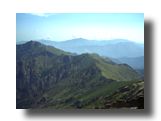 From Capu Biancu, we observed Bocca di Serra Piana carefully. The North side of the pass shows a nice green
color and doesn't look especially intimidating. However, it is actually covered with alders. These small trees
are not dangerous in any way, but they form an inextricable mass of branches, which makes progress very difficult
and reduces visibility to a few meters. Once you're in them, getting out can be a challenge. No obvious path
was visible through them, either from Capu Biancu or from the pass itself. After returning to the pass, we
decided it would be safer to wait until the next morning, so we'd have plenty of time ahead of us.
From Capu Biancu, we observed Bocca di Serra Piana carefully. The North side of the pass shows a nice green
color and doesn't look especially intimidating. However, it is actually covered with alders. These small trees
are not dangerous in any way, but they form an inextricable mass of branches, which makes progress very difficult
and reduces visibility to a few meters. Once you're in them, getting out can be a challenge. No obvious path
was visible through them, either from Capu Biancu or from the pass itself. After returning to the pass, we
decided it would be safer to wait until the next morning, so we'd have plenty of time ahead of us.
We walked back to la Menta and lied down for a nap. We were surroundered by a few cows (unattended animals are common in Corsica) and a crying bull. Flies buzzed. Everything was peaceful.
We had dinner and prepared for the night. Since the huts were ruined, we slept outside. There was a flat area surroundered by a wall whose purpose was to keep animals in; we used it to keep them out. The night was cool and perfectly still.
The alders were a real maze. You can't see further than five meters in there, and you can't walk straight because there are long branches all over the place. Happily, these trees have no thorns, and it was actually rather fun. We weren't entirely alone; sometimes we would see leaves moving at a distance, and pigs could be heard, but remained unseen. We were whistling the tune of "Mission : Impossible"; our mission, which we had chosen to accept, was to get out of there!
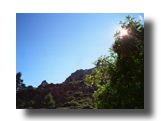 We made it. We actually found a cairn right in the middle of the trees, totally invisible from a distance.
I suppose there used to be a path once, but it was covered by the alders. We were quite proud of finding it!
We went on. The alders disappeared and were replaced by bad, eroded terrain, and we arrived at Bergerie de
Cabane, a lone disused hut. From there on, the path roughly followed the river, but was still very difficult
to find, and each new cairn spotted was a victory!
We made it. We actually found a cairn right in the middle of the trees, totally invisible from a distance.
I suppose there used to be a path once, but it was covered by the alders. We were quite proud of finding it!
We went on. The alders disappeared and were replaced by bad, eroded terrain, and we arrived at Bergerie de
Cabane, a lone disused hut. From there on, the path roughly followed the river, but was still very difficult
to find, and each new cairn spotted was a victory!
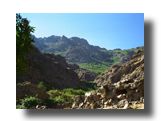 Further down the valley were several ruined huts which once formed a village called Murcella. We ate there. There
were trouts in the river. A group of youngsters passed nearby; they were the first people we had seen since
leaving Corscia... After that point, the path became visible again and we followed it easily. It led us to
river Asco, near the village of the same name. An old Genovese bridge allows crossing the river and we had
planned to bathe there. Unfortunately we weren't alone, because a road leads to the bridge! But a short walk
down the river led us to a quieter place, near a ruined mill.
Further down the valley were several ruined huts which once formed a village called Murcella. We ate there. There
were trouts in the river. A group of youngsters passed nearby; they were the first people we had seen since
leaving Corscia... After that point, the path became visible again and we followed it easily. It led us to
river Asco, near the village of the same name. An old Genovese bridge allows crossing the river and we had
planned to bathe there. Unfortunately we weren't alone, because a road leads to the bridge! But a short walk
down the river led us to a quieter place, near a ruined mill.
We followed the road up to the village and once again started to worry about food and shelter for the night. There are no shops in Asco; merchants drive up every few days with trucks. We were lucky enough to find such a truck, whose owner was selling fruit. We found a restaurant and tried to have dinner there, but they were all booked. We were starving and the restaurant's owner was nice enough to sell us excellent bread and sausage at a friendly price.
We still had to find water and a place to sleep. We talked with two women who showed us the fountain. A nice, old fountain, but once again, well hidden! The older woman was from a family of shepherds and talked of her country with pride. She told us of renowned alpinists who were found frozen near Monte Cinto, a piece of cheese still in their hands - "ce n'est pas de la montagne à vaches," she said. She was right: Corsican mountains are not to be taken lightly. They can be as whimsical as the next mountain...
There was nowhere to sleep in the village except inside disused gardens, which are the only flat places. The two women encouraged us to pick one, even though they are private property. We settled for one of them and were careful to remain unheard and unseen...
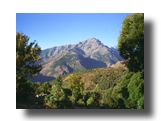 Looking back, one could see Bocca di Sierra Piana, which we had left the day before, and the ridge which led
from it to Capu Biancu.
Looking back, one could see Bocca di Sierra Piana, which we had left the day before, and the ridge which led
from it to Capu Biancu.
At Sant'Angelo, the path suddenly disappeared and we found ourselves again in the middle of thorny bushes. The pass was clearly visible above us, so there was no way we could get lost, but it took some courage to reach it through the thorns. Although it was 9 in the morning, the sun was already terribly hot. We reached the ridge anxiously, hoping the other side would look better. Actually it was just as tricky: the bushes looked thicker than ever on the other side, and the path was still nowhere to be seen. The absence of a path was now more of a problem, since it wasn't obvious any more where to go.
We went on, using the map and the altimeter to try to stay on course. We found a camera that must have been dropped there at least 25 years ago. Was that a good or a bad sign? Anyway, we were lucky and eventually found a hint of a path and a few cairns which seemed to be going in the right direction. They led us to a few trees and we decided we had earned a good siesta.
 After crossing the Ruisseau de Monte Padro, we reached a few farms. There we found a dirt road which was easy
to follow. It was also rather boring, but getting there had been difficult enough and we were pleased to be
able to walk without thinking. We finally reached Maison Forestière de Tartagine-Melaja at the end of the
afternoon and had a wonderfully refreshing bath in the beautiful torrent.
After crossing the Ruisseau de Monte Padro, we reached a few farms. There we found a dirt road which was easy
to follow. It was also rather boring, but getting there had been difficult enough and we were pleased to be
able to walk without thinking. We finally reached Maison Forestière de Tartagine-Melaja at the end of the
afternoon and had a wonderfully refreshing bath in the beautiful torrent.
We spent the night there. The fountain was dry, so we drank from the torrent with a few pills. It was very quiet at night, except for some weird animal noises which kept startling me... Bats, boars? My imagination was running wild. Lying in a sleeping bag in the middle of a forest can make one feel very helpless!
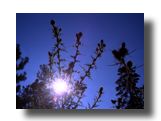 In the morning, we followed the road for a few miles. It led us from Tartagine valley to Melaja valley. When
we reached the Melaja river, we left the road and went up into the forest, following a large trail. There are
actually two trails in this forest; the new one is excellent for cars, but it's long and boring for hikers. The
old one is partly blocked and much smaller, but it's also much nicer for walking. We followed it.
In the morning, we followed the road for a few miles. It led us from Tartagine valley to Melaja valley. When
we reached the Melaja river, we left the road and went up into the forest, following a large trail. There are
actually two trails in this forest; the new one is excellent for cars, but it's long and boring for hikers. The
old one is partly blocked and much smaller, but it's also much nicer for walking. We followed it.The trail reached the end of the forest and stopped. We filled our flasks at a nice spring. We were now in the open. Our next goal was Bocca di Pozzi, the pass which closes the valley, and Monte Grosso, a renowned summit with a nice panorama. We met a large group of boar hunters who showed us the way. The path was well cairned. We felt rather uncomfortable walking in the middle of a boar hunt, but happily it was just over; we saw another group carrying a boar down the mountain.
The sun was boiling as we climbed up to the pass. Unfortunately, clouds appeared as we reached it, and we decided not to try for Monte Grosso. The view would most likely be blocked anyway, and there was still a long way to go. We were disappointed by this new trick of the wheather - the summer hadn't been typical at all.
So we went down the other side, towards Calenzana. This time, the path had completely vanished, and the terrain was bad. We skied: the soil crumbled at each footstep and it was easier to run in an ample, continuous fashion than to walk. We still had to stop regularly to find our way, though, because the slope was very steep and we were afraid of finding cliffs below us. We were lucky enough to discover a path marked out with red paint. It helped a lot - the place was a mess.
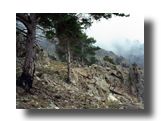 It had been a forest once, but it was completely burnt out. A peasant told us later that it had burnt three years
before. Yet little vegetation had grown since then; it still looked like we were on the Moon. The contrast with
the other side of the pass was striking! That's why campfires are strictly forbidden in Corsica; use a camping
stove.
It had been a forest once, but it was completely burnt out. A peasant told us later that it had burnt three years
before. Yet little vegetation had grown since then; it still looked like we were on the Moon. The contrast with
the other side of the pass was striking! That's why campfires are strictly forbidden in Corsica; use a camping
stove.
After stopping at another nice spring, we resumed the descent. The path split into several new paths and we had to make choices. Happily our destination, the dirt road at the bottom of the valley, was clearly visible ahead of us. The city of Calvi, perched on a hill next to the sea, was visible in the distance.
We finally reached the dirt road, followed it down for a few miles and reached a few houses. Near the houses we found water and a nice place to sleep; in no time, we had eaten and were ready for the night. Even though we skipped Monte Grosso, it had been an 11 hour walk.
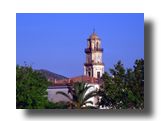 When we woke up, we realized we were very near Calenzana; after a twenty minutes walk, we reached the village and
had breakfast at a bar's terrace. Calenzana is a nice, medium-sized village. It was the biggest since Calacuccia
though, and we felt like we had walked from the mountains into a metropolis in a quarter of an hour!
When we woke up, we realized we were very near Calenzana; after a twenty minutes walk, we reached the village and
had breakfast at a bar's terrace. Calenzana is a nice, medium-sized village. It was the biggest since Calacuccia
though, and we felt like we had walked from the mountains into a metropolis in a quarter of an hour!The trip was now over. We still had three days left though, so we hitch-hiked to Calvi's airport and rented a car. We intended to do some regular tourism, and particularly to visit a few restaurants...
We drove to Saint-Florent, a rather chic town on the North shore, and spent the night there. We had dinner in a nice fish restaurant called "La Gaffe".
 In the morning, we visited a nearby village called Murato. A very nice village, with nice old houses, beautiful
churches, and an amazing number of shops for a village of this size.
In the morning, we visited a nearby village called Murato. A very nice village, with nice old houses, beautiful
churches, and an amazing number of shops for a village of this size.We spent the afternoon on a beach near Saint-Florent - thoroughly boring. I already knew I couldn't take two weeks of this; I discovered even a few hours were a torture!
In the evening, we tried another excellent restaurant called "Pietra Moneta", at the junction of roads N1197 and D81. Then we drove to the mouth of river Ostriconi and spent the night on the beach. Surprisingly, we weren't alone, but there was plenty of room.
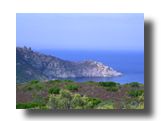 Since farniente was so boring, we decided to hike again. We visited Désert des Agriates, a deserted area
near the sea. There are no roads and water is unknown there, so there are also few tourists! But it's a nice
place, with unusual plants, including cacti. Besides, it is near the sea, and a little-known path led us to a
deserted beach. The water was hot and clear and there was a lot of life underwater - amazing. This place would
be nice for biking too.
Since farniente was so boring, we decided to hike again. We visited Désert des Agriates, a deserted area
near the sea. There are no roads and water is unknown there, so there are also few tourists! But it's a nice
place, with unusual plants, including cacti. Besides, it is near the sea, and a little-known path led us to a
deserted beach. The water was hot and clear and there was a lot of life underwater - amazing. This place would
be nice for biking too.
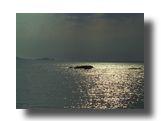 We went back to the beach at Ostriconi and had a last bath under the evening sun. L'Ile-Rousse was visible
in the distance. We knew we'd be back to Paris
the next day and didn't want out of the water... But there was still something to look forward to: dinner!
We went back to the beach at Ostriconi and had a last bath under the evening sun. L'Ile-Rousse was visible
in the distance. We knew we'd be back to Paris
the next day and didn't want out of the water... But there was still something to look forward to: dinner!
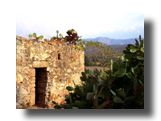 While walking back to the car, we passed near a few nice old houses. Some of them had been restored and were
inhabited. Others were empty - they were just cubes of stone. They looked kind of Mexican to me.
While walking back to the car, we passed near a few nice old houses. Some of them had been restored and were
inhabited. Others were empty - they were just cubes of stone. They looked kind of Mexican to me.
We drove to Olmi Cappella and had dinner at restaurant La Tornade. We had been told this place was mythical; it was indeed. Soup, 3 hors-d'oeuvre, 3 meats with 6 vegetable dishes, the most aggressive cheese in Corsica (it actually hurt!) and dessert... After leaving this most commendable place, we collapsed into our sleeping bags. The night was actually awful, because an apocalyptic storm forced us to finish it inside the car, but I still have a fond memory of this evening...
 After a quick visit of Calvi, we flew back to mainland France, our heads spinning with memories. A few hours
were enough to be back home. My Macs were waiting like faithful dogs... waiting for me to write this story.
Phew, done!
After a quick visit of Calvi, we flew back to mainland France, our heads spinning with memories. A few hours
were enough to be back home. My Macs were waiting like faithful dogs... waiting for me to write this story.
Phew, done!